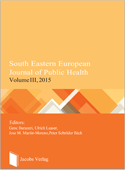South Eastern European Journal of Public Health Volume III, 2015

Download
2015
The former communist countries of South Eastern Europe (SEE) have been undergoing a rapid process of transformation from state-enforced rigid economies to market-oriented societies in the past 25 years. However, these fast changes have unevenly affected various countries and different segments of the populations within each country.
According to the World Health Organization (WHO), the estimated life expectancy in Albania in 2012 was the lowest in the region among females (75 years vs. 83 years in Greece, which exhibited the highest female life expectancy in the SEE region). The lowest value for male life expectancy in 2012 was observed in Serbia (72 years) followed by Albania, Macedonia and Montenegro (73 years).
A remarkable difference compared with the other neighbouring countries is the particularly small female-to-male gap in life expectancy in Albania, which in 2012 was only two years, whereas it varied in the other SEE countries between five years (for most of the countries) and seven years (in Croatia). This may suggest that smoking has not been very frequent in Albanian males a few decades ago. As a matter of fact, some evidence from the WHO suggests that lung cancer mortality for Albania in the 1980s was much lower than in many other European countries. The male-to-female difference in life expectancy in Eastern European countries is strongly influenced by risk differences mainly smoking, alcohol abuse and road traffic accidents.



